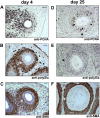Polysialylation of NCAM characterizes the proliferation period of contractile elements during postnatal development of the epididymis
- PMID: 25822229
- PMCID: PMC4379024
- DOI: 10.1371/journal.pone.0123960
Polysialylation of NCAM characterizes the proliferation period of contractile elements during postnatal development of the epididymis
Abstract
Polysialic acid (polySia) attached to the neural cell adhesion molecule (NCAM) regulates inter alia the proliferation and differentiation via the interactions with neurotrophins. Since in postnatal epididymis neurotrophins and their receptors like the Low-Affinity Nerve Growth Factor Receptor p75 and TrK B receptor are expressed, we wanted to analyze if the polysialylation of NCAM is also involved during the development of the epididymis. To this end, we monitored the developmental changes in the expression of the polysialyltransferases and NCAM polysialylation using murine epididymis at different time points during postnatal development. Our results revealed that during postnatal development of the epididymis both polysialyltransferases, ST8SiaII and ST8SiaIV, were expressed and that the expression levels dropped with increasing age. In agreement with the expression levels of the polysialyltransferases the highest content of polysialylated NCAM was present during the first 10 days after birth. Interestingly, proliferating smooth muscle cell populations prevalently expressed polysialylated NCAM. Furthermore, we observed that inverse to the decrease in polysialylation of smooth muscle cells a strong up-regulation of collagen takes place suggesting a functional relationship since collagen was recently described to induce the turnover of polysialylated NCAM via an induction of endocytosis in cellulo. The same time course of polySia and collagen synthesis was also observed in other regions of the male reproductive system e.g. vas deferens and tunica albuginea (testis). Together, we identified a spatio-temporal expression pattern of polySia-NCAM characterized by high proliferation rate of smooth muscle cells and low collagen content.
Conflict of interest statement
Figures








References
-
- Simon P, Bäumner S, Busch O, Röhrich R, Kaese M, Richterich P, et al. Polysialic Acid Is Present in Mammalian Semen as a Post-translational Modification of the Neural Cell Adhesion Molecule NCAM and the Polysialyltransferase ST8SiaII. J Biol Chem 2013;288: 18825–18833. 10.1074/jbc.M113.451112 - DOI - PMC - PubMed
-
- Galuska SP, Geyer R, Gerardy-Schahn R, Mühlenhoff M, Geyer H. Enzyme-dependent Variations in the Polysialylation of the Neural Cell Adhesion Molecule (NCAM) in Vivo. J Biol Chem 2008;283: 17–28. - PubMed
Publication types
MeSH terms
Substances
LinkOut - more resources
Full Text Sources
Other Literature Sources
Research Materials
Miscellaneous

